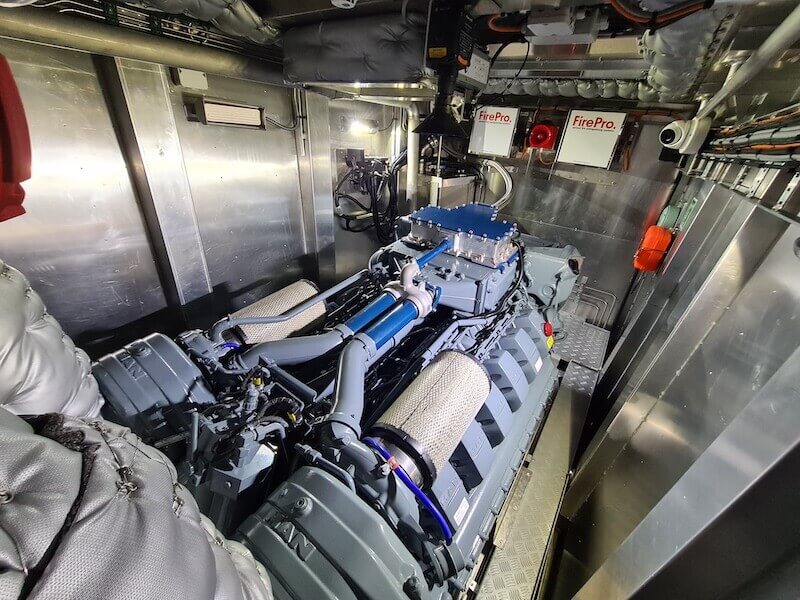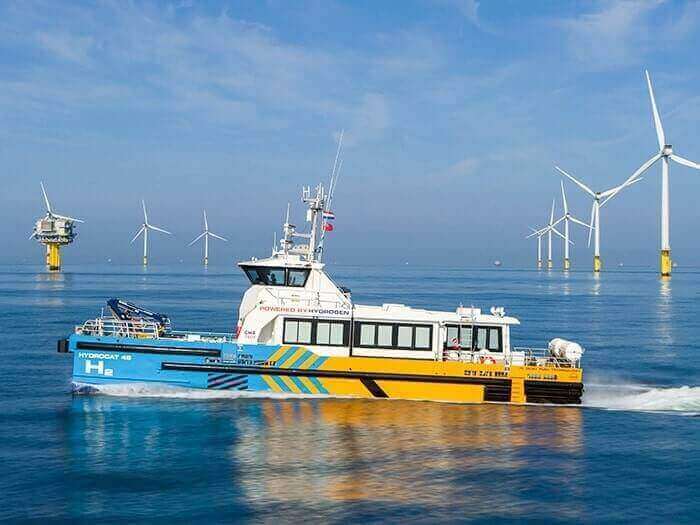MAN Engines introduces the first hydrogen dual fuel engine for workboats

June 02, 2022
The world’s first dual-fuel hydrogen and diesel-powered crew transfer vessel (CTV) is already in service, with the cleaner fuel reducing traditional fuel use and related pollutants by up to 80%. Hydrocat 48, a 25-meter yacht operated by Windcat Workboats, a subsidiary of Compagnie Maritime Belge (CMB), is based on the Windcat MK 3.5 design but has been stretched to accommodate appropriate hydrogen storage.
In May, the vessel, which was certified by Lloyd’s Register and the United Kingdom Maritime and Coastguard Agency, finished bunkering and sea testing. It has two 12-cylinder MAN D2862 LE448 diesel engines with IMO Tier III certification and a selective catalytic reduction (SCR) exhaust gas after-treatment system.
Both V12 engines have been adapted for dual fuel operation by MAN Engines and augmented with a hydrogen injection system by CMB’s cleantech branch CMB.TECH, which was the first to create a hydrogen-powered passenger shuttle, Hydroville, in 2017.
“The applicability of this technology for a CTV is mostly due to the flexibility to use current diesel engines,” said Roy Campe, CMB.TECH’s chief technical officer. “There are no fundamental alterations to the primary engine, which means that not only will maintenance and repair be straightforward, but the engine can also be readily switched back to diesel fuel without any adjustments.”
The vessel can run on standard fuel even if hydrogen is not available, making it a very resilient and stable alternative for the offshore wind sector. “What makes our technology unique is that we employ a standard diesel engine that does not need to be modified for hydrogen,” said Werner Kübler, head of development at MAN Engines.
“Hydrogen is supplied into the charge air via an adaptor and added to the combustion cycle in a proven V12 marine engine. As a result, the combustion process is initiated using the diesel principle, which necessitates the injection of around 5% diesel fuel. For dual-fuel operation, the diesel fuel common rail injection settings have been improved.”
“MAN Engines has a long history of developing fuel-efficient and dependable diesel engines, notably those for workboats. We were also able to attain the best consumption numbers in dual-fuel operation and assure the same operating behavior as diesel running at full load, based on this experience. At the same time, we cut CO2 emissions by an average of 50 percent, and even up to 80 percent in extreme cases,” Kübler added.

Hydrocat 48 can serve as a model for additional dual-fuel, and eventually totally hydrogen-powered CTVS, according to Willem Van Der Wel, managing director of Windcat Workboats. “This vessel provides the industry with a cost-effective option for reducing emissions from service vessels that can be used to any wind farm today. This method might be thought of as the first step toward entirely hydrogen-powered CTVs. We can make hydrogen technology practical in the industry and kick-start future development of the technology, legislation, supply chain, and so on, by starting with dual fuel combustion engines,” he stated.
CMB.TECH has announced that it is collaborating with Windcat Workboats to improve engine capabilities and hydrogen utilization. The firm’s long-term strategy is to build the technology and infrastructure necessary to operate a mono-fuel internal combustion engine in the future (ICE).
While there has been a considerable movement toward hydrogen applications in the maritime sector, the hydrogen supply chain still has to expand to become freely available in additional regions, which is projected to happen in the next years.
Meanwhile, CMB.TECH and Windcat have created a hydrogen bunkering solution to be used in the early stages of the fuel’s development. CMB.TECH has created a 40-foot, 500-bar trailer for remote refueling of any systems that utilize the present technology. The Hydrocat 48 CTV is one of the many applications that may be served by a single machine.
Windcat has three further boats under construction with joint venture partners TSM and FRS that can be delivered with hydrogen technology on board, and additional CTV designs incorporating this technology are being explored.
Source: Marinelink
Click here to join our Telegram chanel
You will get information, news, and support related to Merchant Navy.
